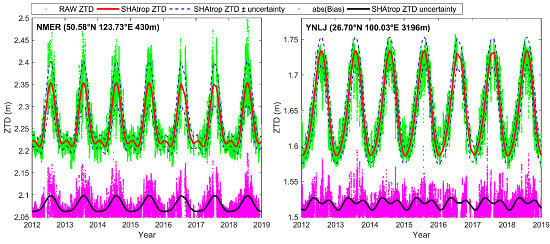SHAtropE—A Regional Gridded ZTD Model for China and the Surrounding Areas
Abstract
1. Introduction
2. Input Data
Temporal Variation of RAW ZTD Time Series
3. Model Determination of SHAtropE
3.1. ZTD with the Ellipsoid as Reference Surface
3.2. ZTD Temporal Variations on the Ellipsoid
3.3. Gridded ZTD Modeling of SHAtropE
- For each site, RAW ZTD from SHA (CMONOC sites) and NGL (Non-COMONC sites) are used to derive the five functional parameters A0, A1, d1, A2, d2 and the five ZTD uncertainty functional parameters B0, B1, f1, B2, f2, based on Equations (1) and (2), respectively.
- For each site, the five ZTD functional parameters of empirical model are converted to the ellipsoid using the exponential function and the constants in in Table 1, and the related parameters on the ellipsoid, i.e., A0,e, A1,e, and A2,e are derived.
- Divide the study areas [70°E–135°E, 18°N–54°N] as grids with a resolution of 2.5° and 2.0° on longitude and latitude, respectively. The 5 ZTD functional parameters on the ellipsoid of each grid point is derived by the inverse distance weighted (IDW) function [37] using the parameters of nearby sites. And the ZTD uncertainty functional parameters B0, B1, f1, B2, f2 for each grid could also be derived by the IDW approach.
4. Assessment of SHAtropE
4.1. ZTD Accuracy of SHAtropE
4.2. The Predicted ZTD Uncertainty of SHAtropE
4.3. Precise Point Positioning Performance Improvement Using SHAtropE Model
5. Conclusions
Author Contributions
Funding
Acknowledgments
Conflicts of Interest
References
- Böhm, J.; Schuh, H. Atmospheric Effects in Space Geodesy; Böhm, J., Schuh, H., Eds.; Springer: Berlin, Germany, 2013; pp. XVII, 234. [Google Scholar]
- MacMillan, D.S.; Ma, C. Evaluation of very long baseline interferometry atmospheric modeling improvements. J. Geophys. Res. Solid Earth 1994, 99, 637–651. [Google Scholar] [CrossRef]
- Fernandes, M.J.; Lazaro, C.; Ablain, M.; Pires, N. Improved wet path delays for all ESA and reference altimetric missions. Remote Sens. Environ. 2015, 169, 50–74. [Google Scholar] [CrossRef]
- Wu, Z.; Wang, J.; Liu, Y.; He, X.; Liu, Y.; Xu, W. Validation of 7 Years in-Flight HY-2A Calibration Microwave Radiometer Products Using Numerical Weather Model and Radiosondes. Remote Sens. 2019, 11, 1616. [Google Scholar] [CrossRef]
- Bevis, M.; Businger, S.; Herring, T.A.; Rocken, C.; Anthes, R.A.; Ware, R.H. GPS Meteorology—Remote Sensing of Atmospheric Water Vapor Using the Global Positioning System. J. Geophys. Res. Atmos. 1992, 97, 15787–15801. [Google Scholar] [CrossRef]
- Hobiger, T.; Ichikawa, R.; Takasu, T.; Koyama, Y.; Kondo, T. Ray-traced troposphere slant delays for precise point positioning. Earth Planets Space 2008, 60, e1–e4. [Google Scholar] [CrossRef][Green Version]
- Yao, Y.; Yu, C.; Hu, Y. A New Method to Accelerate PPP Convergence Time by using a Global Zenith Troposphere Delay Estimate Model. J. Navig. 2014, 67, 899–910. [Google Scholar] [CrossRef]
- Lu, C.; Li, X.; Zus, F.; Heinkelmann, R.; Dick, G.; Ge, M.; Wickert, J.; Schuh, H. Improving BeiDou real-time precise point positioning with numerical weather models. J. Geod. 2017, 91, 1019–1029. [Google Scholar] [CrossRef]
- Yao, Y.; Peng, W.; Xu, C.; Cheng, S. Enhancing real-time precise point positioning with zenith troposphere delay products and the determination of corresponding tropospheric stochastic models. Geophys. J. Int. 2017, 208, 1217–1230. [Google Scholar] [CrossRef]
- Zheng, F.; Lou, Y.; Gu, S.; Gong, X.; Shi, C. Modeling tropospheric wet delays with national GNSS reference network in China for BeiDou precise point positioning. J. Geod. 2017, 92, 545–560. [Google Scholar] [CrossRef]
- Wang, J.; Liu, Z. Improving GNSS PPP accuracy through WVR PWV augmentation. J. Geod. 2019. [Google Scholar] [CrossRef]
- Andrei, C.-O.; Chen, R. Assessment of time-series of troposphere zenith delays derived from the Global Data Assimilation System numerical weather model. GPS Solut. 2008, 13, 109–117. [Google Scholar] [CrossRef]
- Chen, Q.; Song, S.; Heise, S.; Liou, Y.-A.; Zhu, W.; Zhao, J. Assessment of ZTD derived from ECMWF/NCEP data with GPS ZTD over China. GPS Solut. 2011, 15, 415–425. [Google Scholar] [CrossRef]
- Hopfield, H.S. Two-quartic tropospheric refractivity profile for correcting satellite data. J. Geophys. Res. 1969, 74, 4487–4499. [Google Scholar] [CrossRef]
- Saastamoinen, J. Atmospheric Correction for the Troposphere and Stratosphere in Radio Ranging Satellites. In The Use of Artificial Satellites for Geodesy; Henriksen, S.W., Mancini, A., Chovitz, B.H., Eds.; American Geophysical Union: Washington, DC, USA, 1972; pp. 247–251. [Google Scholar]
- Collins, J.P.; Langley, R.B. A Tropospheric Delay Model for the User of the Wide Area Augmentation System; Department of Geodesy and Geomatics Engineering, University of New Brunswick: Fredericton, NB, Canada, 1997. [Google Scholar]
- Leandro, R.F.; Langley, R.B.; Santos, M.C. UNB3m_pack: A neutral atmosphere delay package for radiometric space techniques. GPS Solut. 2007, 12, 65–70. [Google Scholar] [CrossRef]
- Penna, N.; Dodson, A.; Chen, W. Assessment of EGNOS tropospheric correction model. J. Navig. 2001, 54, 37–55. [Google Scholar] [CrossRef]
- Boehm, J.; Heinkelmann, R.; Schuh, H. Short Note: A global model of pressure and temperature for geodetic applications. J. Geod. 2007, 81, 679–683. [Google Scholar] [CrossRef]
- Kouba, J. Testing of global pressure/temperature (GPT) model and global mapping function (GMF) in GPS analyses. J. Geod. 2009, 83, 199–208. [Google Scholar] [CrossRef]
- Lagler, K.; Schindelegger, M.; Bohm, J.; Krasna, H.; Nilsson, T. GPT2: Empirical slant delay model for radio space geodetic techniques. Geophys. Res. Lett. 2013, 40, 1069–1073. [Google Scholar] [CrossRef]
- Böhm, J.; Möller, G.; Schindelegger, M.; Pain, G.; Weber, R. Development of an improved empirical model for slant delays in the troposphere (GPT2w). GPS Solut. 2015, 19, 433–441. [Google Scholar] [CrossRef]
- Landskron, D.; Böhm, J. VMF3/GPT3: Refined discrete and empirical troposphere mapping functions. J. Geod. 2017, 92, 349–360. [Google Scholar] [CrossRef]
- Askne, J.; Nordius, H. Estimation of tropospheric delay for microwaves from surface weather data. Radio Sci. 1987, 22, 379–386. [Google Scholar] [CrossRef]
- Li, W.; Yuan, Y.; Ou, J.; Li, H.; Li, Z. A new global zenith tropospheric delay model IGGtrop for GNSS applications. Chin. Sci. Bull. 2012, 57, 2132–2139. [Google Scholar] [CrossRef]
- Li, W.; Yuan, Y.; Ou, J.; Chai, Y.; Li, Z.; Liou, Y.-A.; Wang, N. New versions of the BDS/GNSS zenith tropospheric delay model IGGtrop. J. Geod. 2014, 89, 73–80. [Google Scholar] [CrossRef]
- Yao, Y.; Hu, Y.; Yu, C.; Zhang, B.; Guo, J. An improved global zenith tropospheric delay model GZTD2 considering diurnal variations. Nonlinear Process. Geophys. 2016, 23, 127–136. [Google Scholar] [CrossRef]
- Yao, Y.; Zhang, B.; Xu, C.; He, C.; Yu, C.; Yan, F. A global empirical model for estimating zenith tropospheric delay. Sci. China Earth Sci. 2015, 59, 118–128. [Google Scholar] [CrossRef]
- Chen, J.; Wu, B.; Hu, X.; Li, H. SHA: The GNSS Analysis Center at SHAO. China Satell. Navig. Conf. (CSNC) 2012 Proc. 2012, 160, 213–221. [Google Scholar] [CrossRef]
- Blewitt, G.; Hammond, W.; Kreemer, C. Harnessing the GPS Data Explosion for Interdisciplinary Science. Eos 2018, 99. [Google Scholar] [CrossRef]
- Rzepecka, Z. Time series analysis of radio signal WET tropospheric delays for short-term forecast. Acta Geodyn. Geomater. 2015, 345–354. [Google Scholar] [CrossRef][Green Version]
- Chen, J.; Zhang, Y.; Zhou, X.; Pei, X.; Wang, J.; Wu, B. GNSS clock corrections densification at SHAO: From 5 min to 30 s. Sci. China Phys. Mech. Astron. 2013, 57, 166–175. [Google Scholar] [CrossRef]
- Wang, J.; Junping, C.; Jiexian, W.; Jiejun, Z.; Lei, S. Assessment of Tropospheric Delay Correction Models over China. Geomat. Inf. Sci. Wuhan Univ. 2016, 41, 1656–1663. [Google Scholar]
- Jin, S.; Park, J.-U.; Cho, J.-H.; Park, P.-H. Seasonal variability of GPS-derived zenith tropospheric delay (1994–2006) and climate implications. J. Geophys. Res. 2007, 112. [Google Scholar] [CrossRef]
- Lou, Y.; Huang, J.; Zhang, W.; Liang, H.; Zheng, F.; Liu, J. A New Zenith Tropospheric Delay Grid Product for Real-Time PPP Applications over China. Sensors 2017, 18, 65. [Google Scholar] [CrossRef] [PubMed]
- Wang, J.; Wu, Z.; Semmling, M.; Zus, F.; Gerland, S.; Ramatschi, M.; Ge, M.; Wickert, J.; Schuh, H. Retrieving Precipitable Water Vapor From Shipborne Multi-GNSS Observations. Geophys. Res. Lett. 2019, 46, 5000–5008. [Google Scholar] [CrossRef]
- Janssen, V.; Ge, L.; Rizos, C. Tropospheric corrections to SAR interferometry from GPS observations. GPS Solut. 2004, 8, 140–151. [Google Scholar] [CrossRef]
- Boehm, J.; Niell, A.; Tregoning, P.; Schuh, H. Global Mapping Function (GMF): A new empirical mapping function based on numerical weather model data. Geophys. Res. Lett. 2006, 33. [Google Scholar] [CrossRef]
- Petit, G.; Luzum, B. IERS Conventions (2010) (IERS Technical Note No. 36); IERS: Frankfurt am Main, Germany, 2010. [Google Scholar]
- Wu, J.T.; Wu, S.C.; Hajj, G.A.; Bertiger, W.I.; Lichten, S.M. Effects of Antenna Orientation on GPS Carrier Phase. Manuscr. Geod. 1993, 18, 91–98. [Google Scholar]
- Guo, F.; Li, X.; Zhang, X.; Wang, J. Assessment of precise orbit and clock products for Galileo, BeiDou, and QZSS from IGS Multi-GNSS Experiment (MGEX). GPS Solut. 2016, 21, 279–290. [Google Scholar] [CrossRef]

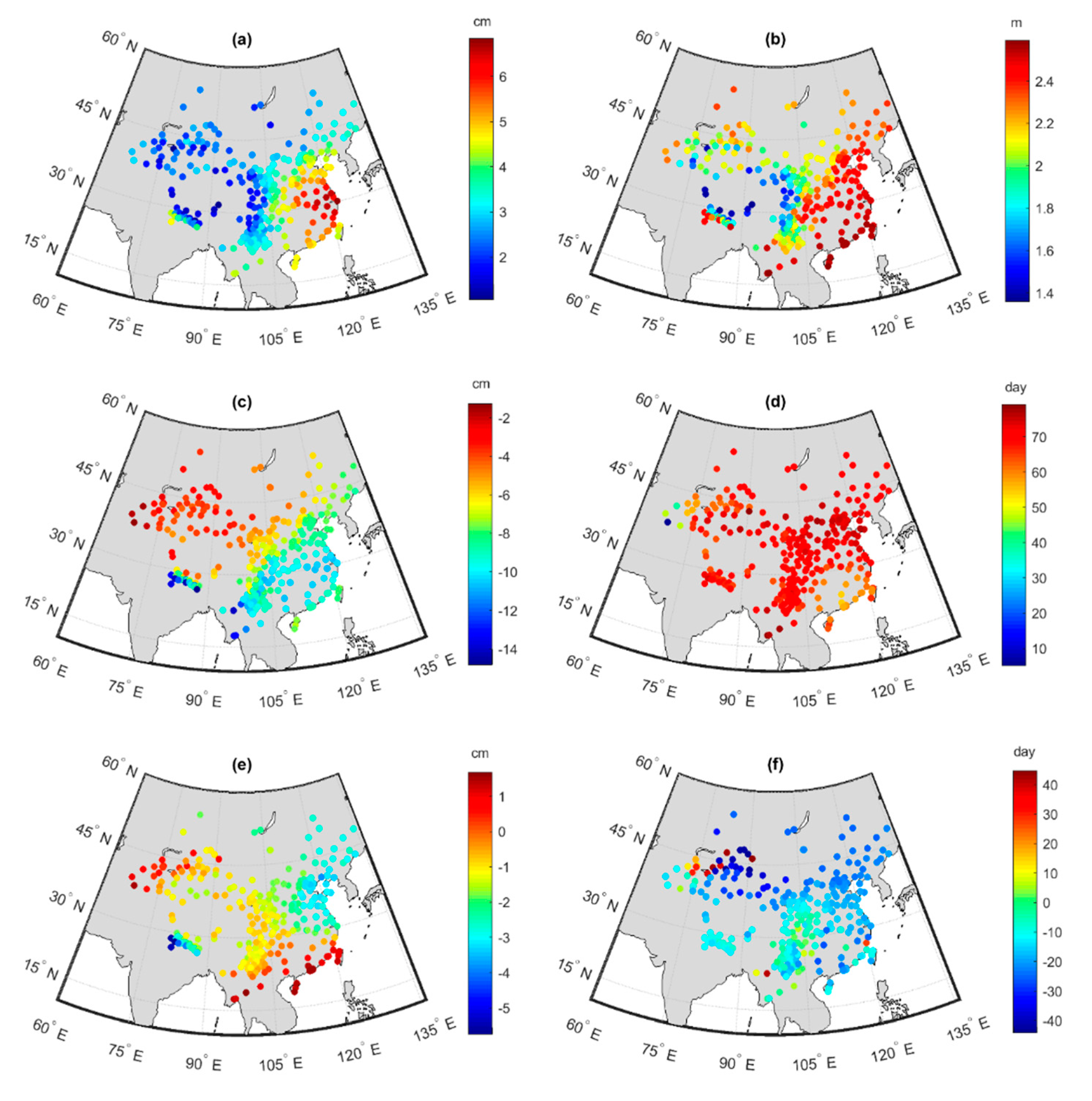
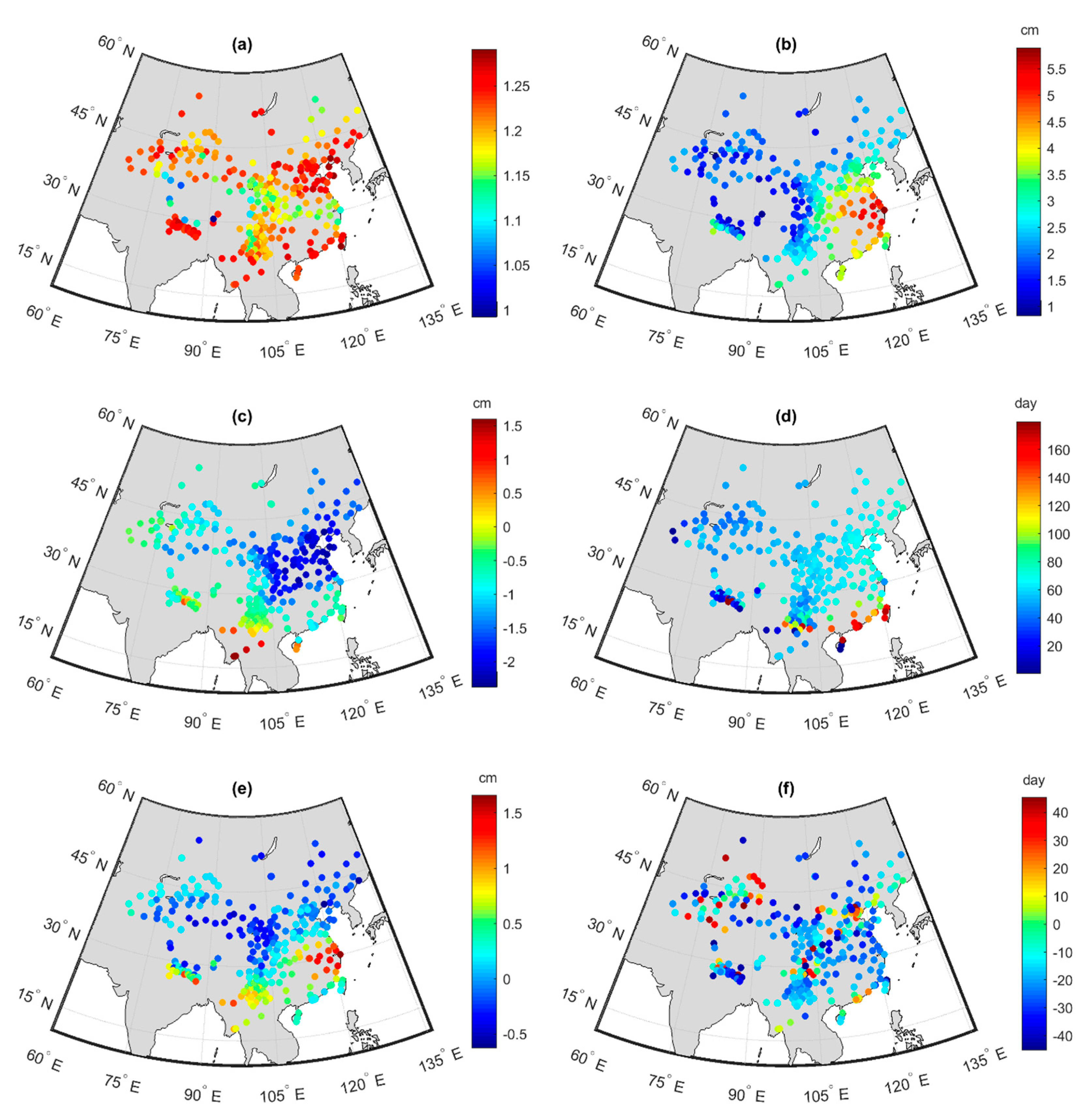
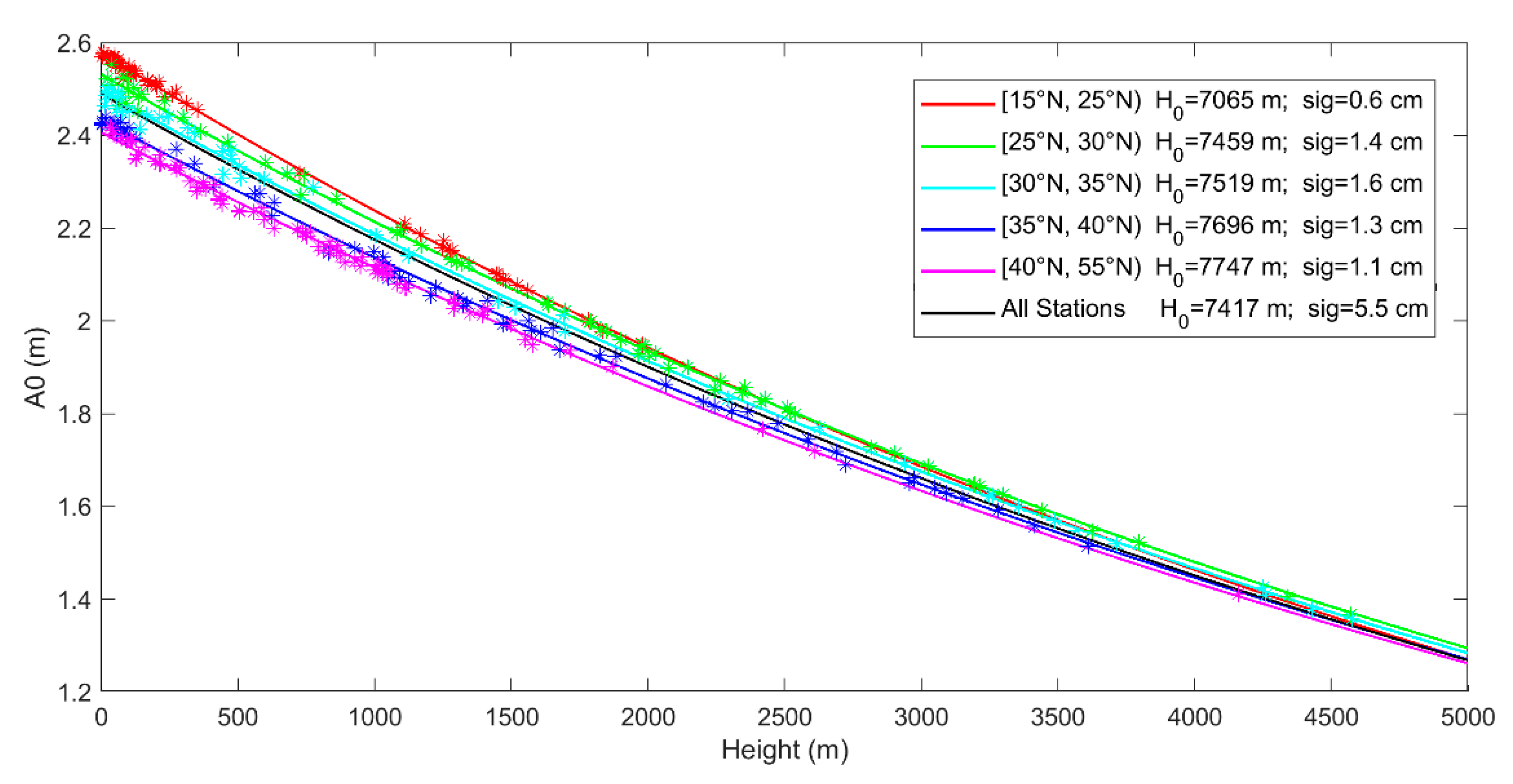
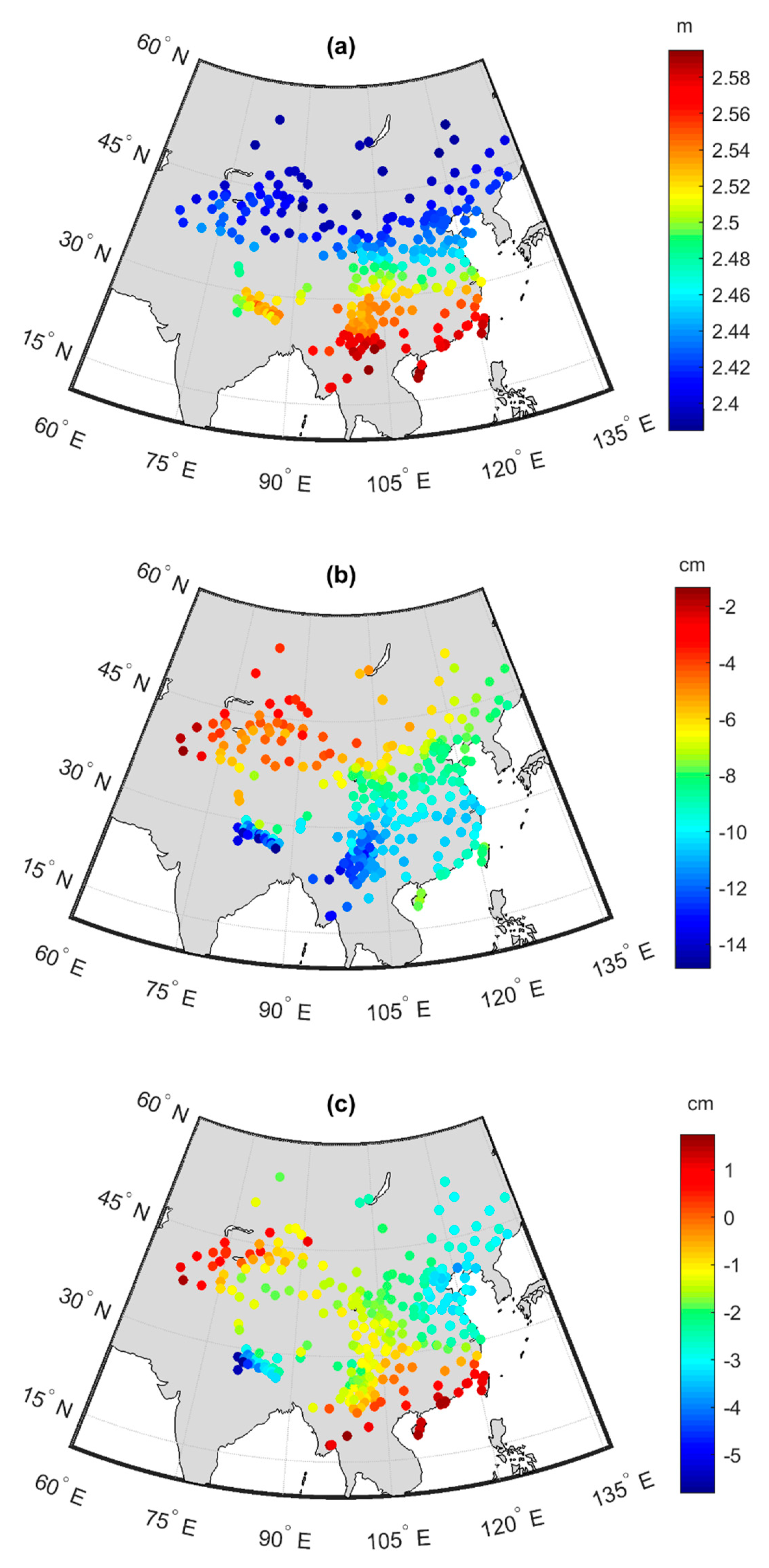
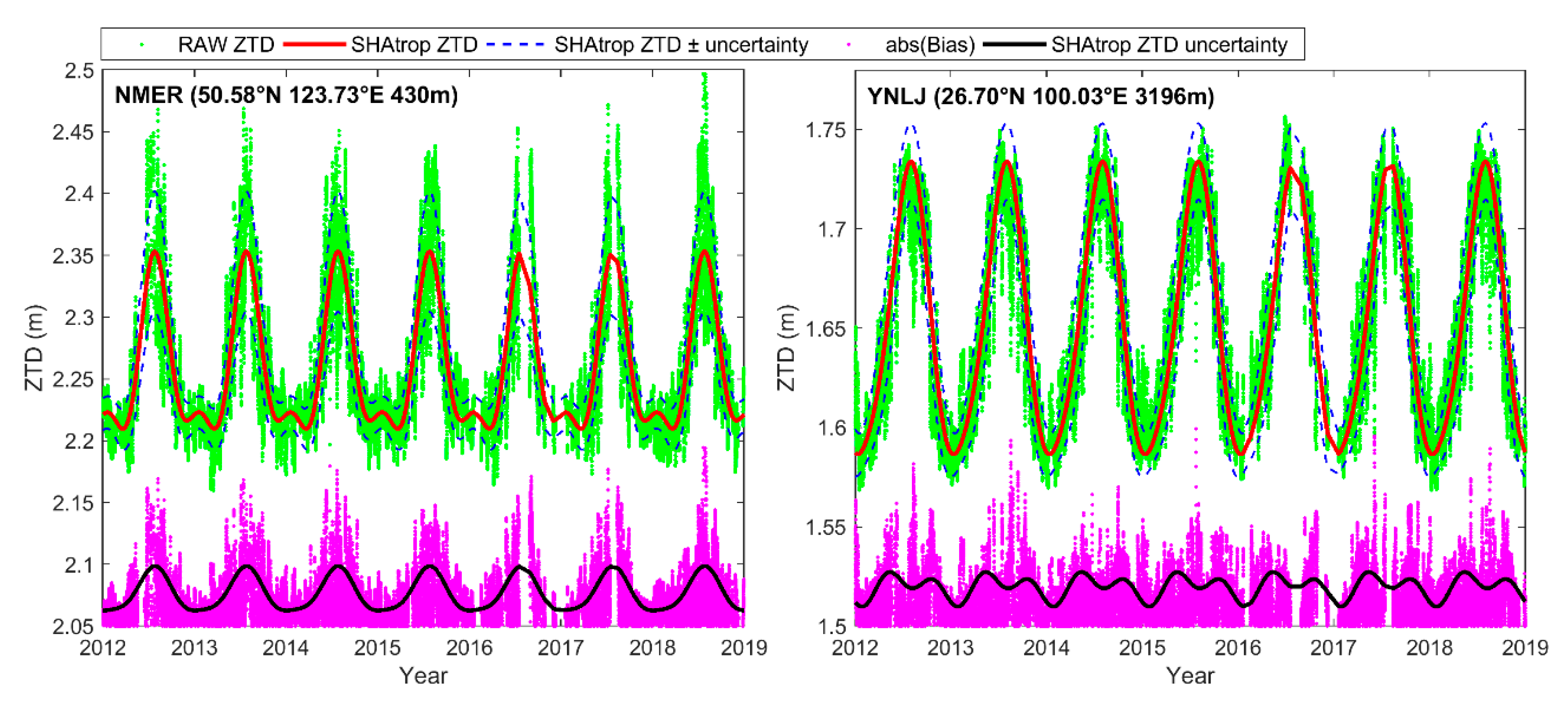

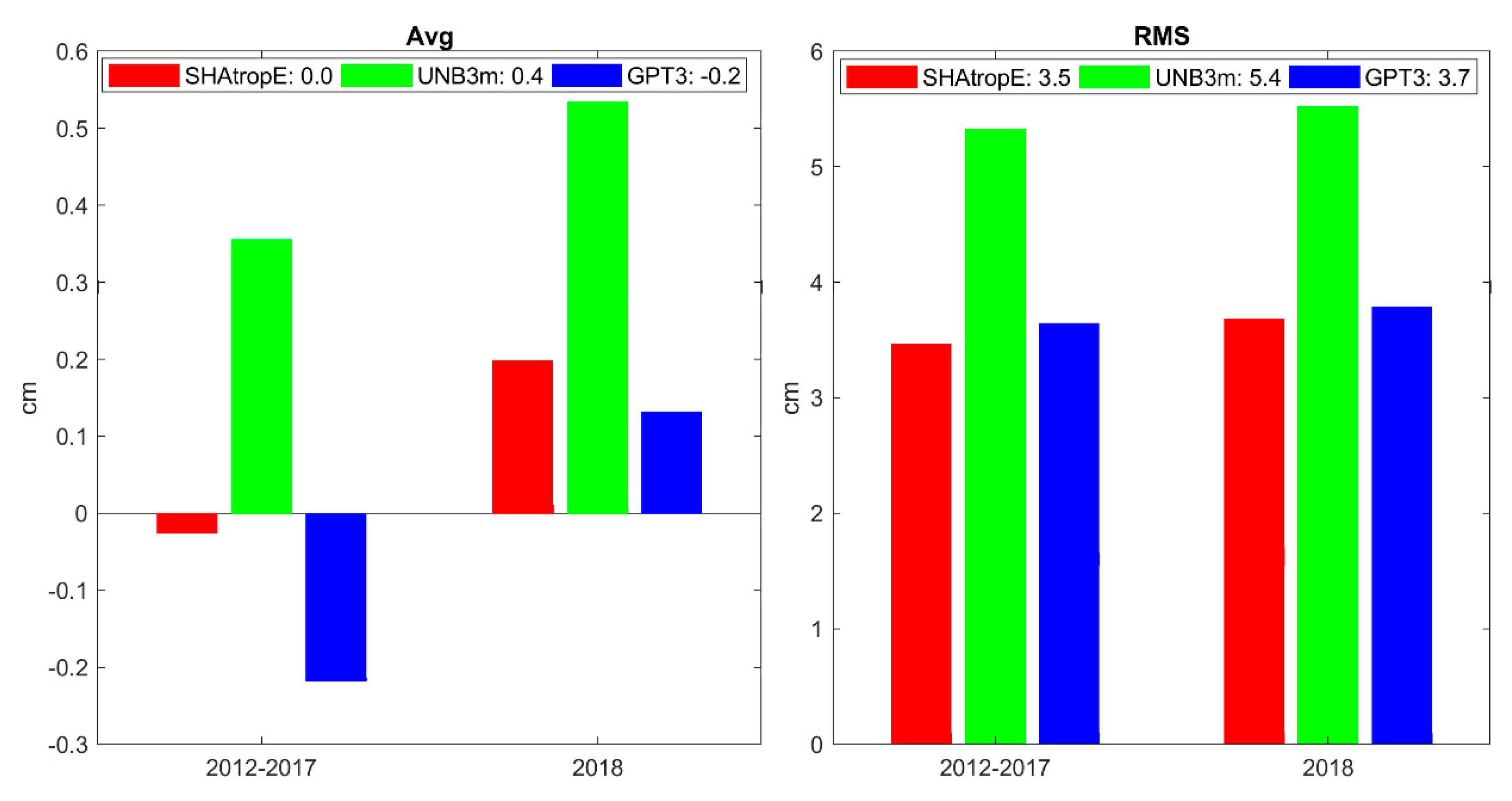
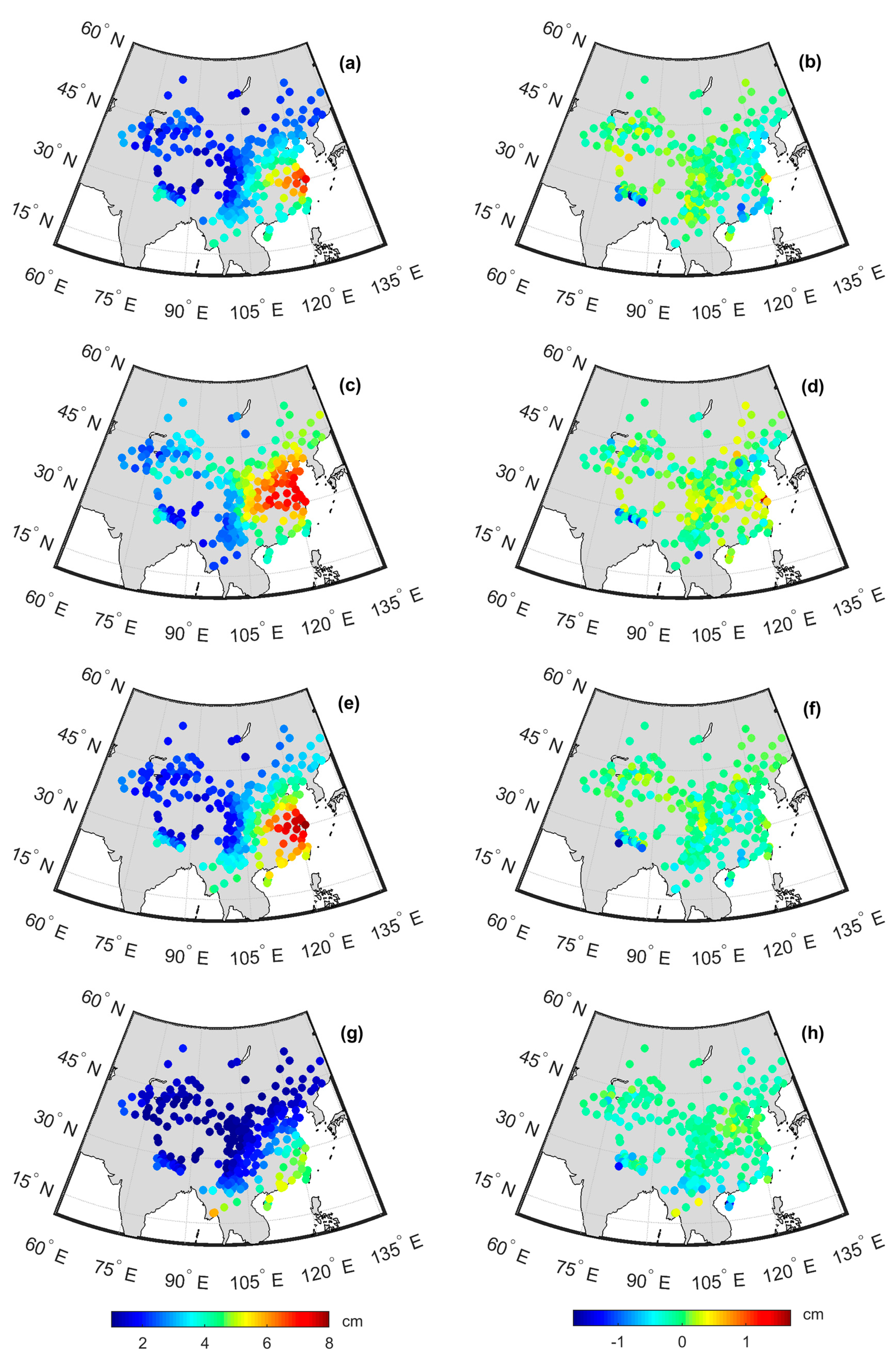

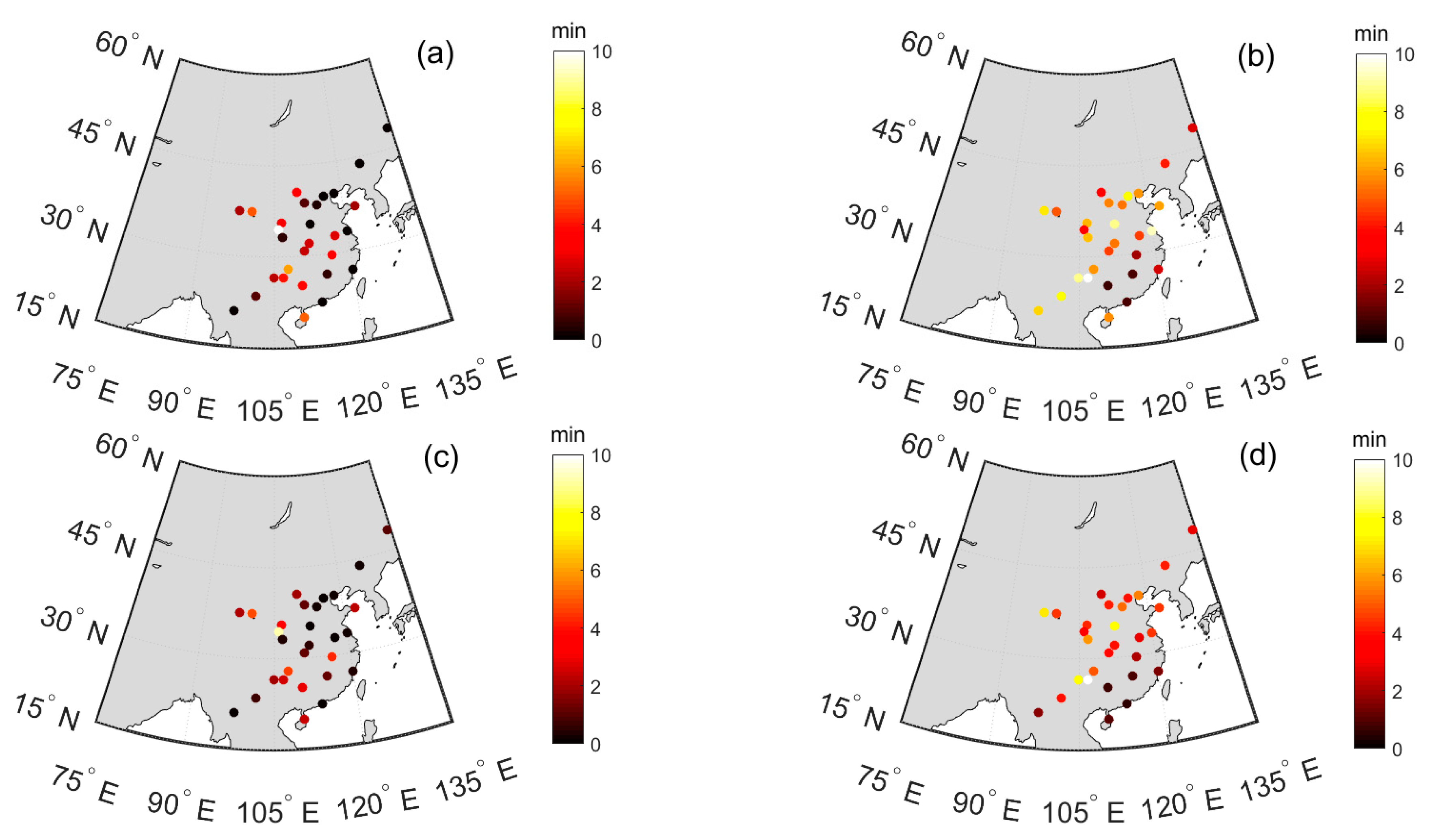
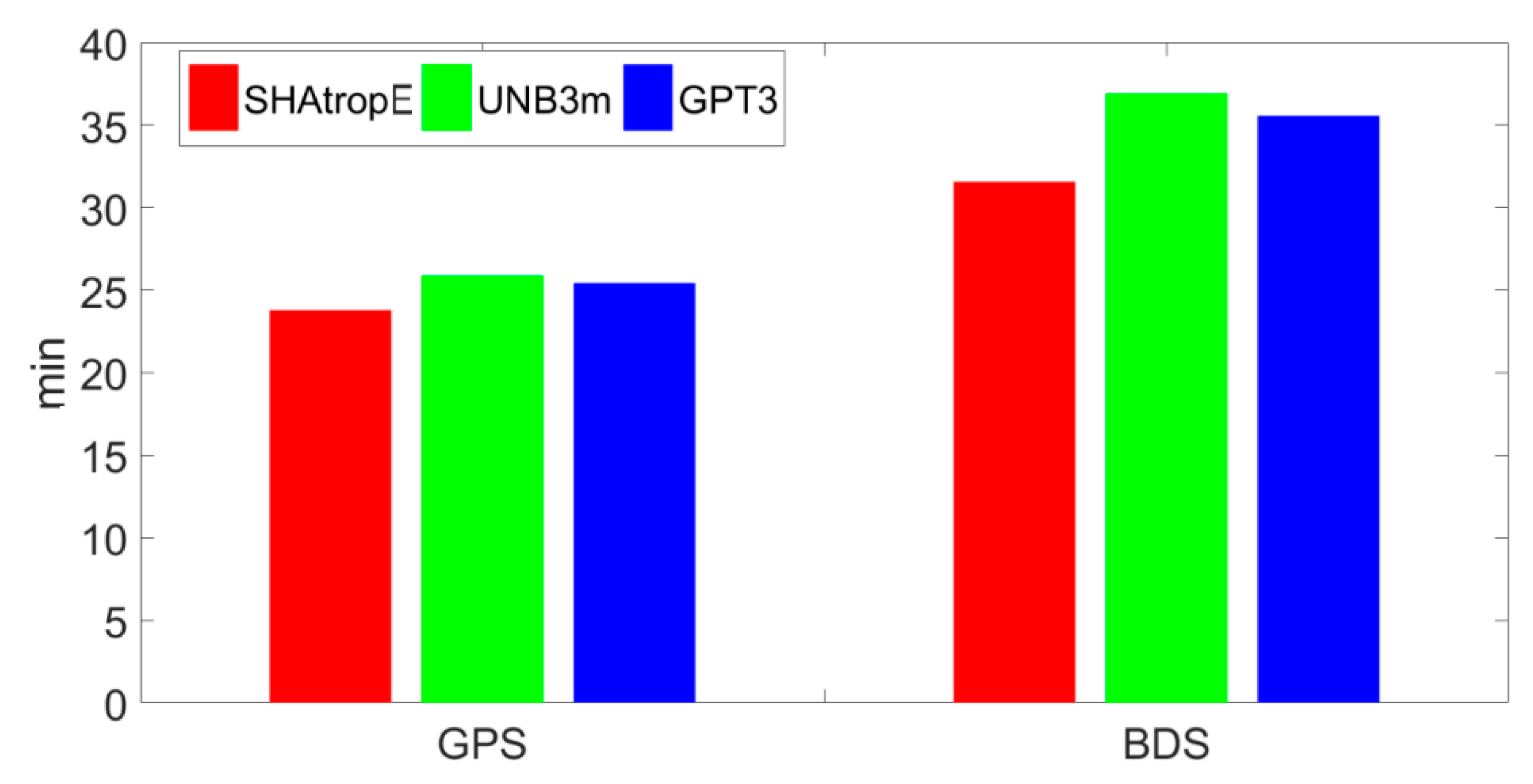
| Latitude | (m) |
|---|---|
| 15°N–25°N | 7065 |
| 25°N–30°N | 7459 |
| 30°N–35°N | 7519 |
| 35°N–40°N | 7696 |
| 40°N–55°N | 7747 |
| Raw Observation | RAW ZTD Spans | Spatial Resolution | Spatial Distribution |
|---|---|---|---|
| CMONOC, NGL | January 2012–December 2018 | 2.5° (Longitude) × 2.0° (Latitude) | 70°E–135°E, 18°N–54°N |
| Item | Models/Strategies |
|---|---|
| Frequency selection | GPS: L1/L2; BDS: B1/B2 |
| Estimator | Kalman filter |
| Sampling rate | 30 s |
| Elevation cutoff angle | 10° |
| Satellite orbit and clock | Fixed to GFZ final orbit and clock offset products |
| Satellite differential code bias (DCB) | Correct using MGEX DCB products |
| Receiver and Satellite antenna | GPS PCO (phase center offset)/PCV (phase center variation) corrected with igs14.atx, BDS PCO corrected with the value released by ESA and PCV is not considered |
| Tropospheric delay | Modeled for the dry part and estimated for wet part as random-walk noise process; GMF [38] mapping function applied |
| Ionospheric delay | Eliminated by Ionosphere-free combinations |
| Tidal effects | Corrected by IERS Convention 2010, including solid tide and ocean tide loading [39] |
| Relativistic effects | Corrected by model |
| Phase windup | Corrected by model [40] |
| Weighing strategy | A priori precision of 0.003m and 0.3m for GPS phase and code; A priori precision of 0.003m and 0.6m for BDS phase and code; Elevation-dependent weighing (1 for otherwise ) is used |
| Site coordinates | Estimated as constants |
| Receiver clock | Estimated as white noise process |
| Phase ambiguities | Estimated as float constants for each arc |
© 2020 by the authors. Licensee MDPI, Basel, Switzerland. This article is an open access article distributed under the terms and conditions of the Creative Commons Attribution (CC BY) license (http://creativecommons.org/licenses/by/4.0/).
Share and Cite
Chen, J.; Wang, J.; Wang, A.; Ding, J.; Zhang, Y. SHAtropE—A Regional Gridded ZTD Model for China and the Surrounding Areas. Remote Sens. 2020, 12, 165. https://doi.org/10.3390/rs12010165
Chen J, Wang J, Wang A, Ding J, Zhang Y. SHAtropE—A Regional Gridded ZTD Model for China and the Surrounding Areas. Remote Sensing. 2020; 12(1):165. https://doi.org/10.3390/rs12010165
Chicago/Turabian StyleChen, Junping, Jungang Wang, Ahao Wang, Junsheng Ding, and Yize Zhang. 2020. "SHAtropE—A Regional Gridded ZTD Model for China and the Surrounding Areas" Remote Sensing 12, no. 1: 165. https://doi.org/10.3390/rs12010165
APA StyleChen, J., Wang, J., Wang, A., Ding, J., & Zhang, Y. (2020). SHAtropE—A Regional Gridded ZTD Model for China and the Surrounding Areas. Remote Sensing, 12(1), 165. https://doi.org/10.3390/rs12010165





